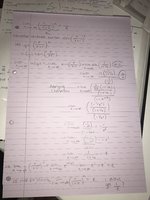You are using an out of date browser. It may not display this or other websites correctly.
You should upgrade or use an alternative browser.
You should upgrade or use an alternative browser.
Where am I going wrong - limit of sequence
- Thread starter Sophdof1
- Start date
I follow your work fine up through this step:
\(\displaystyle \lim_{x \to \infty} \frac{\ln \left( \frac{1}{1+ \frac{1}{x}} \right)}{\frac{1}{x}}\)
But after that you lose me completely. You write that you're applying L'Hopital's Rule, but that doesn't look like any application of the rule I've ever seen. You should end up with:
\(\displaystyle \lim_{x \to \infty} \frac{\frac{d}{dx} \left[ \ln \left( \frac{1}{1+ \frac{1}{x}} \right) \right]}{\frac{d}{dx} \left[ \frac{1}{x} \right]}\)
\(\displaystyle = \lim_{x \to \infty} \frac{\frac{1}{x^2+x}}{-\frac{1}{x^2}}\)
When you simply that down, you'll get:
\(\displaystyle \lim_{x \to \infty} \ln(y(x)) = -1 \implies \lim_{x \to \infty} y(x) = e^{-1} = \frac{1}{e}\)
\(\displaystyle \lim_{x \to \infty} \frac{\ln \left( \frac{1}{1+ \frac{1}{x}} \right)}{\frac{1}{x}}\)
But after that you lose me completely. You write that you're applying L'Hopital's Rule, but that doesn't look like any application of the rule I've ever seen. You should end up with:
\(\displaystyle \lim_{x \to \infty} \frac{\frac{d}{dx} \left[ \ln \left( \frac{1}{1+ \frac{1}{x}} \right) \right]}{\frac{d}{dx} \left[ \frac{1}{x} \right]}\)
\(\displaystyle = \lim_{x \to \infty} \frac{\frac{1}{x^2+x}}{-\frac{1}{x^2}}\)
When you simply that down, you'll get:
\(\displaystyle \lim_{x \to \infty} \ln(y(x)) = -1 \implies \lim_{x \to \infty} y(x) = e^{-1} = \frac{1}{e}\)
pka
Elite Member
- Joined
- Jan 29, 2005
- Messages
- 11,971
I am not at all sure what exactly you are asking. If it is to derive the limit \(\displaystyle \mathop {\lim }\limits_{n \to \infty } {\left( {\frac{n}{{n + 1}}} \right)^n} = \frac{1}{e}\) or to prove it?Why am I not getting 1/e?? Instead I get e?
I am so stressed as I thought I had finally found the answer. Does anyone see the flaw in my solution? I don't see where I'm going wrong.
Help would be so apreciated.
Here is a general principal: \(\displaystyle \mathop {\lim }\limits_{n \to \infty } {\left( {1 + \frac{a}{{n + b}}} \right)^{cn}} = {e^{ac}}\).
If we have proven (or were given) that rule then note that \(\displaystyle \left( {\frac{n}{{n + 1}}} \right) = \left( {1 + \frac{{ - 1}}{{n + 1}}} \right)\),
hence \(\displaystyle \mathop {\lim }\limits_{n \to \infty } {\left( {1 + \frac{{ - 1}}{{n + 1}}} \right)^n} = {e^{ - 1}}\) (i.e. \(\displaystyle a=-1\)).
If you are asking to derive the principal then that requires an entire section of an advanced text.
pka
Elite Member
- Joined
- Jan 29, 2005
- Messages
- 11,971
I dug through old computer files (from twenty years ago). Here is a file from a lecture on the general principal.Here is a general principal: \(\displaystyle \mathop {\lim }\limits_{n \to \infty } {\left( {1 + \frac{a}{{n + b}}} \right)^{cn}} = {e^{ac}}\).
If you are asking to derive the principal then that requires an entire section of an advanced text.
Because it is converted from slides, you should use the "page down" feature to read the file.

